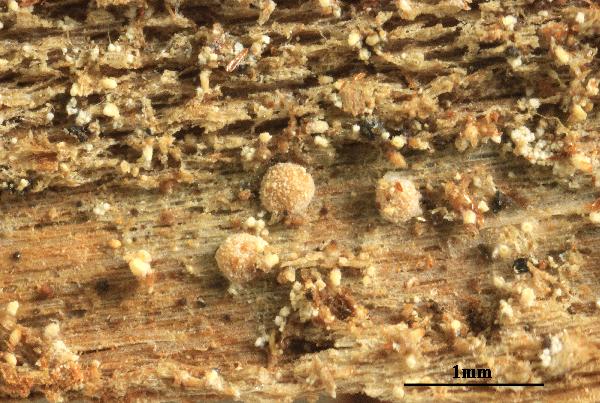Biatora veteranorum Coppins & Sérus.
in Sérusiaux & al., Bryologist, 113: 337, 2010.
Synonyms: Catillaria alba Coppins & Vězda; Coppinsidea alba (Coppins et Vězda) S.Y. Kondr., Farkas & Lőkös
Distribution: N - TAA (Nascimbene 2014, Nascimbene & Marini 2015, Trindade & al. 2021). C - Tosc.
Description: Thallus crustose, very thin, effuse, usually poorly evident. Apothecia biatorine, round, 0.15-0.4 mm across, white to pale brown or pale pinkish brown, with a strongly convex, often pruinose disc, without a distinct margin. Proper exciple colourless, poorly developed, of conglutinated, radiating, thick-walled hyphae; epithecium pale yellow-orange, with minute crystals dissolving in K; hymenium colourless, 25-35 μm high; paraphyses simple or sparingly branched in upper part, 1-1.5(1.7) μm thick at mid-level, the apical cells up to 3 μm wide; hypothecium colourless. Asci 8-spored, clavate, with a K/I+ blue apical dome penetrated by a narrow, K/I– apical cushion surrounded by a narrow, deeply K/I+ blue zone, the wall K/I- but surrounded by an I+ red-brown, K/I+ blue outer layer, the ocular chamber relatively small, Biatora-type. Ascospores 1-septate, hyaline, (6.5-)8-10(-11.5) x 2.3-3 μm. Pycnidia conspicuous, sessile to short-stalked, white-pruinose, 80-120 μm across, 80-150 μm high. Conidia 1-celled, hyaline, bacilliform, 3-4 x c. 1 μm. Photobiont chlorococcoid. Spot tests: thallus and apothecia K-, C-, KC-, P-, UV-. Chemistry: unknown, probably without lichen substances.Note: a cool-temperate lichen found on mostly soft wood of decorticated old deciduous and coniferous trees; certainly rare, but to be looked for elsewhere, especially in the Alps. For further details see Sérusiaux & al. (2010). It is included in the Italian red list of epiphytic lichens as “Critically Endangered” (Nascimbene & al. 2013c).
Growth form: Crustose
Substrata: lignum
Photobiont: green algae other than Trentepohlia
Reproductive strategy: mainly sexual
In underhangs rarely wetted by rain
Commonnes-rarity: (info)
Alpine belt: absent
Subalpine belt: absent
Oromediterranean belt: absent
Montane belt: extremely rare
Submediterranean belt: absent
Padanian area: absent
Humid submediterranean belt: absent
Humid mediterranean belt: absent
Dry mediterranean belt: absent

Predictive model
Herbarium samples


Felix Schumm - CC BY-SA 4.0
[VZR53], Austria . Tirolia. Hohe Tauern: Virgen, Hinteregg, 1600 m,
ad truncum putridum Laricis. - isotypus. Leg. A. V zda 1.9.1988. EX
A. V ZDA: LICHENES RARIORES EXSICCATI NR. 53. As Catillaria alba
Growth form: Crustose
Substrata: lignum
Photobiont: green algae other than Trentepohlia
Reproductive strategy: mainly sexual
In underhangs rarely wetted by rain
Commonnes-rarity: (info)
Alpine belt: absent
Subalpine belt: absent
Oromediterranean belt: absent
Montane belt: extremely rare
Submediterranean belt: absent
Padanian area: absent
Humid submediterranean belt: absent
Humid mediterranean belt: absent
Dry mediterranean belt: absent

Predictive model
| Herbarium samples |


 INDEX FUNGORUM
INDEX FUNGORUM
 GBIF
GBIF
 DOLICHENS
DOLICHENS



